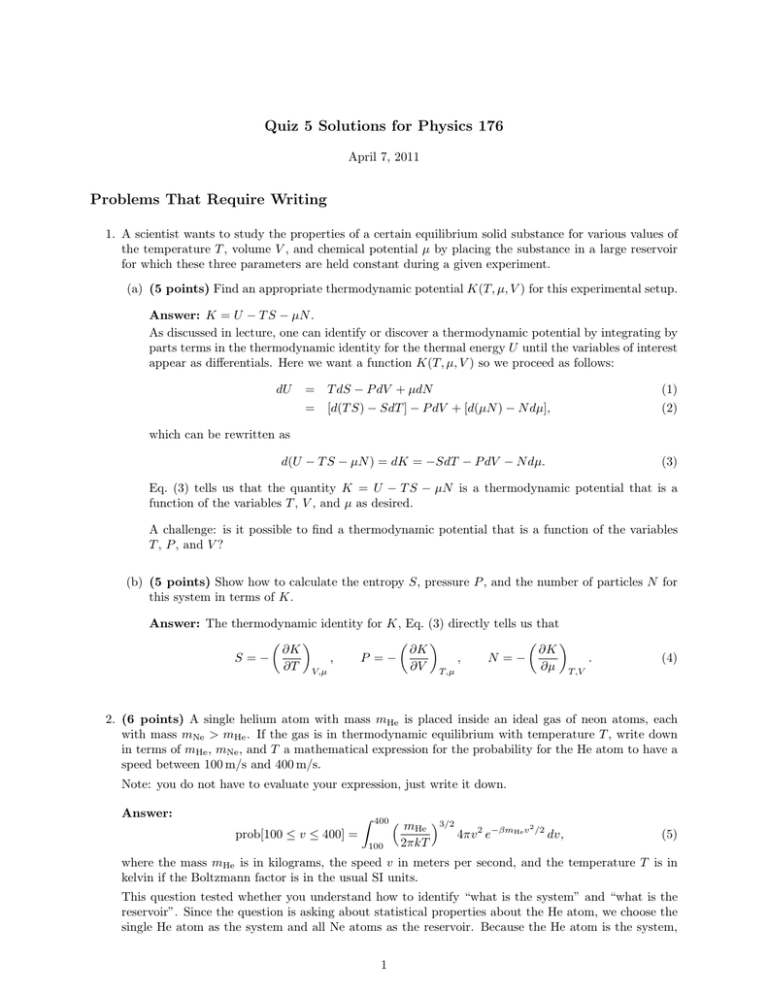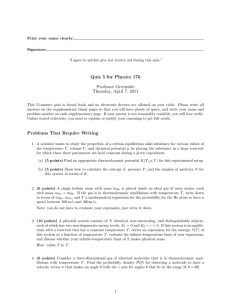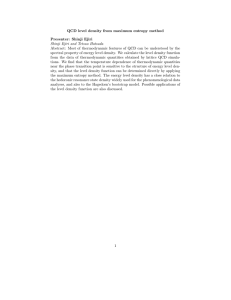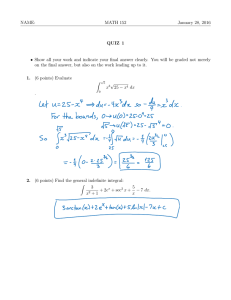Quiz 5 Solutions for Physics 176 Problems That Require Writing
advertisement

Quiz 5 Solutions for Physics 176
April 7, 2011
Problems That Require Writing
1. A scientist wants to study the properties of a certain equilibrium solid substance for various values of
the temperature T , volume V , and chemical potential µ by placing the substance in a large reservoir
for which these three parameters are held constant during a given experiment.
(a) (5 points) Find an appropriate thermodynamic potential K(T, µ, V ) for this experimental setup.
Answer: K = U − T S − µN .
As discussed in lecture, one can identify or discover a thermodynamic potential by integrating by
parts terms in the thermodynamic identity for the thermal energy U until the variables of interest
appear as differentials. Here we want a function K(T, µ, V ) so we proceed as follows:
dU
= T dS − P dV + µdN
= [d(T S) − SdT ] − P dV + [d(µN ) − N dµ],
(1)
(2)
which can be rewritten as
d(U − T S − µN ) = dK = −SdT − P dV − N dµ.
(3)
Eq. (3) tells us that the quantity K = U − T S − µN is a thermodynamic potential that is a
function of the variables T , V , and µ as desired.
A challenge: is it possible to find a thermodynamic potential that is a function of the variables
T , P , and V ?
(b) (5 points) Show how to calculate the entropy S, pressure P , and the number of particles N for
this system in terms of K.
Answer: The thermodynamic identity for K, Eq. (3) directly tells us that
∂K
∂K
∂K
S=−
,
P =−
,
N =−
.
∂T V,µ
∂V T,µ
∂µ T,V
(4)
2. (6 points) A single helium atom with mass mHe is placed inside an ideal gas of neon atoms, each
with mass mNe > mHe . If the gas is in thermodynamic equilibrium with temperature T , write down
in terms of mHe , mNe , and T a mathematical expression for the probability for the He atom to have a
speed between 100 m/s and 400 m/s.
Note: you do not have to evaluate your expression, just write it down.
Answer:
Z
400
prob[100 ≤ v ≤ 400] =
100
m 3/2
2
He
4πv 2 e−βmHe v /2 dv,
2πkT
(5)
where the mass mHe is in kilograms, the speed v in meters per second, and the temperature T is in
kelvin if the Boltzmann factor is in the usual SI units.
This question tested whether you understand how to identify “what is the system” and “what is the
reservoir”. Since the question is asking about statistical properties about the He atom, we choose the
single He atom as the system and all Ne atoms as the reservoir. Because the He atom is the system,
1
the energies Es that appear in the Boltzmann factor and in the partition function Z are the energies
of a non-interacting freely moving He atom:
Es = E(v) =
1
mHe v 2 ,
2
(6)
where the different states of the He atom are labeled by the speed v. The Boltzmann factor for a
state s with energy E(v) is therefore
2
ps = c e−βmHe v /2 ,
(7)
where the constant c is determined by normalization, that the sum of all the probabilities ps must add
to 1. But this means that c can only depend on the mass mHe since the integral over the probabilities
Eq. (7) only involves mHe . The answer must therefore be Eq. (5), the integral of the Maxwell speed
distribution D(v) given at the end of the quiz with all masses equal to the mass of a He atom.
If you look back through Chapter 6, you will notice how the details of the reservoir—what it is made of
or whether the substance is a gas, liquid, or solid—never enter into the Boltzmann factor or partition
function. The only role of the reservoir is to set the temperature T , which in turn determines the
probability of observing particular states of the system via the Boltzmann factor e−βEs .
3. (10 points) A physical system consists of N identical, non-interacting, and distinguishable objects,
each of which has two non-degenerate energy levels, E1 = 0 and E2 = > 0. If this system is in equilibrium with a reservoir that has a constant temperature T , derive an expression for the entropy S(T ) of
this system as a function of temperature T , evaluate the infinite-temperature limit of your expression,
and discuss whether your infinite-temperature limit of S makes physical sense.
Hint: relate S to F .
Answer:
and
S = N k ln 1 + e−β +
β
,
eβ + 1
lim S = N k ln(2) = k ln 2N .
T →∞
(8)
(9)
This was the simplest problem I could think of that would give you a chance to calculate the free energy
of some system in terms of the system’s partition function, and then extract some thermodynamic
quantity, here S, from a knowledge of F .
From the thermodynamic identity for F , we can express the entropy S in terms of F and so in terms
of the partition function ZN for the entire system:
∂F
∂
S=−
=
[kT ln (ZN )] .
(10)
∂T V,N
∂T
For microscopic components with two non-degenerate energy levels 0 and > 0, the single particle
partition function Z1 is given by
Z1 = e−β 0 + e−β = 1 + e−β .
(11)
Since you are told that the particles are identical and distinguishable (e.g., the particles may have
fixed identifiable locations in space, like nuclei in a crystalline lattice), the partition function ZN for
the entire system is given by
N
ZN = Z1N = 1 + e−β .
(12)
Several students incorrectly wrote that Ztotal = ZN = Z1 Z2 = e−β(0) e−β = e−β , i.e., the total
partition function was the product of successive Boltzmann factors, one for each energy level. Not sure
how this misunderstanding arose from my lecture or from Schroeder.
2
Substituting Eq. (12) into Eq. (10), we find the following expression for the entropy in terms of the
microscopic energy levels 0 and :
S
=
=
=
=
=
∂
[kT ln (ZN )]
∂T
N i
∂ h
k
T ln 1 + e−β
∂T
∂ Nk
T ln 1 + e−β
∂T
T
−β
−β
+
N k ln 1 + e
·e
·
1 + e−β
kT 2
β
N k ln 1 + e−β + β
,
e +1
(13)
(14)
(15)
(16)
(17)
which is the answer Eq. (8) above.
It is worthwhile to use a little extra time during a quiz or exam (or in general) to see if some mathematical answer makes physical sense since this can help you verify that your derivation was mathematically
correct. For example, the entropy S is an extensive quantity (recall how S is additive for weakly interacting subsystems). But the only other extensive variable in this problem is N , the number of objects,
and so necessarily S ∝ N . Your answer would be wrong if S is not proportional to N , which could
occur if you wrote F = −kT ln(Z1 ) instead of F = −kT ln(ZN ), or if there was another factor of N
somewhere inside the brackets multiplying N k. Your answer also needs to make sense dimensionally.
If there is a leading factor of k which is the correct units for entropy, any factor multiplying k must be
dimensionless. This implies, for example, that you can’t have an by itself multiplying a dimensionless
ratio like 1/(eβ + 1) since that would have units of energy, there has to be some factor like β with
units of inverse energy that combines with to give a dimensionless quantity.
Note how I have written the answer Eq. (8) to emphasize the appearance everywhere of the dimensionless quantity β, which makes clear that S = S(β) depends on temperature only through the
variable β = /(kT ). This makes it easy to plot S as a function of temperature, by plotting S/(N k)
versus 1/x where x = 1/(β) = kT /. For example, if we choose to measure temperature in units
of /k, the factor β becomes 1/T and we can type
Plot[
Log[ 1 + Exp[-1/T] ]
{ T, 0, 5 } ,
PlotRange -> All
]
+
(1/T) / (1 + Exp[1/T]) ,
to see visually how the entropy S/(N k) in Eq. (8) varies with temperature. The result looks like this
0.7
0.6
S H Nk L
0.5
0.4
0.3
0.2
0.1
0.0
0
1
2
3
T
3
4
5
In accord with the third law of thermodynamics, the curve correctly goes to zero as T → 0, and
saturates at a value ≈ 0.7 as T → ∞. We will see in a minute that the infinite temperature limit of
S/(N k) is precisely ln(2) ≈ 0.693.
Challenge: show that Eq. (8) can be rewritten as ln[2 cosh(x)] − x tanh(x) where x = β/2. Eq. (8)
is therefore the same expression as you derived in Problem 3.23 on page 107 of Schroeder for the
entropy S(T ) of a spin-1/2 paramagnet in an external magnetic field (except that x = βµB for that
problem). Thus the entropy dependence on temperature is the same whether or not you have a
thermally isolated system as in Chapter 3 or a system in contact with a reservoir
√ as in Chapter 6.
A quick way to understand this is that the fluctuations in energy σE /hEi ∝ 1/ N is negligible for
large N , so the system in equilibrium with the reservoir behaves almost identically to an isolated
system.
To complete this problem, we want to calculate the infinite temperature limit of Eq. (8). But T → ∞
implies β = /(kT ) → 0 so e±β → 1. As T → ∞, the second term in Eq. (8) goes to zero (the
numerator goes to zero while the denominator goes to 2) and 1 + e−β → 2 in the first term, giving the
second answer, Eq. (9). This looks like the entropy of a system whose multiplicity Ω = 2N which makes
good physical sense: a two-state system is equally likely to be in either of its two states as T → ∞
so the total number of possible states for N particles is 2N . The result Eq. (9) is exactly the same as
the high-temperature limit of the entropy of a paramagnet, see Problem 2.24 on page 67 of Schroeder,
which you solved earlier in Assignment 5.
Note: Strictly speaking, the infinite-temperature multiplicity is
1/2
2
N
N!
≈
2N ≈ 2N ,
(18)
Ω=
=
[(N/2)!]2
πN
N/2
p
by Stirling’s formula. The factor 2/(πN ) is a small factor multiplying a very large factor 2N and so
can be ignored.
4. (6 points) Consider a three-dimensional gas of identical molecules that is in thermodynamic equilibrium with temperature T . Find the probability density D(θ) for observing a molecule to have a
velocity vector v that makes an angle θ with the z axis for angles θ that lie in the range [θ, θ + dθ].
Answer:
D(θ) =
1
sin(θ)
2
A quick way to see this is that, when one integrates the velocity distribution
Z ∞
Z ∞
Z ∞
m 3/2
2
1=
dvx
dvy
dvz
e−βmv /2 ,
2πkT
−∞
−∞
−∞
(19)
(20)
in spherical coordinates
Z
Z
∞
1=
dv
0
Z
π
dθ
0
2π
dφ
0
m 3/2
2
e−βmv /2 v 2 sin(θ),
2πkT
(21)
over the irrelevant variables v and φ (irrelevant in the sense that we want to know the probability
density for θ, no matter what are the values of v and φ), the only remaining functional dependence
is sin(θ). That is, the integrals over v and φ will produce some constant c since the integrand factors
into a product of functions f (v)g(θ)h(φ) that each depend only on a single variable, in which case the
triple integral in spherical coordinates itself factors into a product of one-dimensional integrals, one
over each variable. Eq. (21) becomes
Z π
1=
c sin(θ) dθ,
(22)
0
4
where c is a product of the integral over v (some numbers) with the integral over φ) (some other
number) with the other constant factors already present. Since c sin(θ) is a quantity whose integral
over the range [0, π] is 1, this must be the probability density D(θ) for θ. The integral in Eq. (22) is
easily carried out to give c = 1/2, giving the answer Eq. (19). Note also that sin(θ) is non-negative
over the range 0 ≤ θ ≤ π so Eq. (19) is indeed a non-negative normalized probability distribution.
Alternatively, we can carry out explicitly the integrations in Eq. (21) over φ and over v. The integral
over φ gives a factor of 2π. Multiplying and dividing the resulting integrand by 2 gives
Z π Z ∞ m 3/2 −βmv2 /2 1
dv
dθ
1=
e
× 4πv 2 sin(θ).
(23)
2πkT
2
0
0
But the integral over v is the integral over the Maxwell speed distribution and gives one, leaving the
integral
Z π
1
1=
sin(θ) dθ,
(24)
0 2
giving directly the answer Eq. (19).
Challenge: For the Stern-Gerlach apparatus that involves shooting a beam of magnetic dipoles through
an inhomogeneous magnetic field, the classical prediction would be that the density of silver atoms
that accumulates on the final glass plate should be proportional to the probability density D(µz ) of
observing the z-component of the dipole to lie in some small range [µz , µz + dµz ], assuming that the
dipoles have all possible random angles θ in the interval 0 ≤ θ ≤ 2π. That is, classically the dipoles in
the beam act like identical bar magnets whose orientation θ is uniformly distributed (equally likely).
So given µz = µ cos(θ) and θ is uniformly distributed over [0, 2π], can you calculate D(µz ) and so
predict what Stern and Gerlach should have seen if classical physics were obeyed?
5. (6 points) What is the most likely kinetic energy E = (1/2)mv 2 for a gas of molecules whose speed
distribution D(v) is constant over the range 0 ≤ v ≤ v0 and zero for v > v0 , as shown in the figure
below?
Answer:
Emax = 0.
(25)
To see this, you want to use the same idea of Problem 4 of Assignment 8, in which you showed that the
most likely energy Emax in an equilibrium ideal gas does not correspond to the most likely speed vmax ,
2
i.e., Emax 6= (1/2)mvmax
. (Recall that for some variable x whose statistical properties are described
in terms of a probability density D(x), the most likely value xmax is given by where the density has a
global maximum.)
The general idea is to make a change of variables x → y = y(x) and just read off the resulting
probability distribution for y:
Z x2
Z y2
dx
(26)
1=
D(x) dx =
D[x(y)] dy,
dy
x1
y1
5
where the new bounds are obtained from yi = y(xi ). From Eq. (26), you can read off directly the
probability distribution for y:
dx
D(y) = D x(y)
(27)
dy
Here you are told that the speed distribution D(v) is constant over the range 0 ≤ v ≤ v0 . This means
that the normalized speed distribution satisfies
Z v0
1=
c dv,
(28)
0
where c is the constant value of the distribution. (By carrying out the integral, you can easily see
that c = 1/v0 although the actual value is not needed for this problem.) Given D(v) = c, we can
find the probability density D(E)p
for the energy by changing variables in Eq. (28) to the energy E.
From E = (1/2)mv 2 we have v = 2E/m and so
r
2 1 −1/2
dv =
· E
· dE.
(29)
m 2
Substituting Eq. (29) into Eq. (28) and also changing the integration bounds to the corresponding
values of E, we have
Z (1/2)mv02
1=
c̃ E −1/2 dE,
(30)
0
where the new constant c̃ is given by
c̃ = √
c
.
2m
(31)
From Eq. (30), we conclude that
D(E) =
c̃
E 1/2
,
(32)
which has a global maximum at E = 0, giving the answer Eq. (25). Note that although the function
E −1/2 diverges as E → ∞, the area under the curve is still finite since E −1/2 is an integrable function,
so it is meaningful to treat Eq. (32) as a probability density. Functions that have infinite area or that
have negative values can not be interpreted as a probability density.
The following equations may be useful:
dU = T dS − P dV + µ dN,
β=
1
,
kT
ZN = Z1N
hXi =
X
X
(33)
(34)
for distinguishable independent identical particles.
(35)
e−βU (s) =
s
dn e−βEn ,
ps =
n
hXi =
s
D(v) =
X
F = −kT ln(Z).
e−βEs
.
Z
Z=
R
ps Xs ,
F = U − T S,
m 3/2
2
4πv 2 e−βmv /2 ,
2πkT
v 2 = vx2 + vy2 + vz2 ,
e−βE(q) X(q) dq
R
,
e−βE(q) dq
Z
1=
Z
∞
dvx
−∞
hEi =
X
ps Es = −
s
Z
∞
dvy
−∞
∞
dvz
−∞
m 3/2
2
e−βmv /2 .
2πkT
dvx dvy dvz = v 2 sin(θ) dv dθ dφ.
6
1 ∂Z
.
Z ∂β
(36)
(37)
(38)




